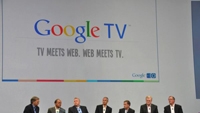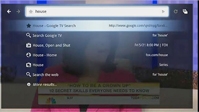Google TV tries new attempt to merge TV, Internet

It has been unsuccessfully tried many times before, but last week Google introduced Google TV, a new effort to turn the living room TV set into a place to navigate websites. This time the interaction goes much deeper than ever before.
Backed by a several major high-tech companies at its developers' conference in San Francisco, Google said the Google TV service would be built into HDTVs and Blu-ray players made by Sony as well as a set-top box made by Logitech. Intel will make the Atom chips to power the box. The devices will go on sale at Best Buy stores in the fall.
So far, consumers have shown little interest in connecting to the Internet through TV sets, and there are formidable challenges in persuading others in the industry to back the effort. However, Google has strong assets, including its Android operating system for mobile phones and a powerful search and advertising system.
When users start any Google TV device, a simple search bar greets them. They then type in what they would like to watch, which can be a TV station or a program. The software will point to places to find the program, whether that’s through a cable subscription channel, Netflix or somewhere on the Web. With this mix of Web and TV, users can also view multiple sources of information in multiple panes.
Using Bluetooth and Wi-Fi, users will also be able to load a Web page from a Google Android phone and beam it to the TV. The Android phone’s voice recognition can be used to search for shows by verbal command. Also, closed-captioning for any TV program will be available through Google Translate in real time.
Google is pitching its new platform as an easy way to search for TV programming and Internet content without having to navigate slow, on-screen directories. For example, search for “House” and you get all the episodes available on USA and Fox as well as on Hulu and for purchase on Amazon. The TV becomes a natural extension of the Web itself, Google said.
Howard Stringer, chief executive of Sony, the third-largest maker of flat-panel TVs in the United States market, appeared on Google’s stage to say Sony would build Google’s software into an HDTV, called the Sony Internet TV, as well as a Blu-ray player.
Get the TV Tech Newsletter
The professional video industry's #1 source for news, trends and product and tech information. Sign up below.

He also said Sony is likely to gradually adopt Google’s software, which he cited as more robust and comprehensive than his company’s own Bravia Internet service for Internet-connected TVs.
Stringer was joined on the stage by the chief executives of Best Buy, Adobe, Intel, Dish Networks and Logitech, where Eric Schmidt, Google’s chief executive, interviewed them about their plans.
Schmidt said that people had been talking about bringing the Web to the TV for two decades. “It’s much harder to marry a 50-year-old technology and a brand-new technology than those of us from the brand-new technology industry thought,” he said.
Logitech’s set-top box will allow users to receive Google TV without having to buy a new TV set. The company said it was also working on keyboard-equipped remote controls and peripherals to allow people to surf the Web from the couch.
Many companies have already tried to bridge the gap between the TV and the Web. Apple, TiVo, Boxee, Roku and Vudu, now a division of Wal-Mart, all make devices that offer a variety of Internet video on TV. All have struggled to gain broad adoption, in part because most consumers have avoided hooking up another set-top box to their TVs.
If Google’s effort is successful, it could create problems for traditional cable companies, because more people could look at content on the Internet and bypass their cable provider’s VOD offerings. Google did not talk about its advertising strategy for Google TV, but it could use its formidable data-collection abilities to aim new types of ads at TV-watching consumers. The company said users would have control over what information was shared with advertisers.
Google, looking to expand beyond its lucrative online advertising business, is betting that more consumers will want to buy TV that can connect to the Internet. ABI Research found that demand for such sets is rising with the popularity of Internet content and estimates that 46 percent of flat-panel TVs will have Internet connections by 2013, up from 19 percent this year.
A subtext to the announcement was Google’s intense competition with Apple and its chief executive, Steve Jobs. Vic Gundotra, vice president for engineering at Google, used the momentum of Android, a free, open-source platform with few rules governing its use, to draw a sharp distinction between the control Apple exerts over devices running the iPhone operating system.
“If you believe that the only way to get a good smart phone is to bet on one man, one device, one carrier and one choice, that is a different model than we believe in,” Gundotra told the New York Times. “We believe innovation doesn’t come from one man; it comes from all of us.”
